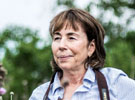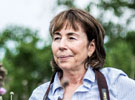SMU's Bonnie Jacobs is searching for history
beyond ancient in the Trinity River bottoms
SMU Paleobotanist Bonnie Jacobs and a team of students are delving into the Trinity River's history.

By Jim Schutze
The Dallas Observer

She and an intrepid crew of graduate students -- Jewel Lipps, Shannon Hart and Hadley McPherson -- are working to create a picture of the land along the Elm Fork that will show what was going on there through recorded history and back into prehistoric times. Working in the area northeast of the former Texas Stadium site, Jacobs and her team hope to come up with a real-life portrait of the land over time, showing not merely what plants were growing here but also what may have been going on in the overall environment, as reflected by changes in plant life.
As it is, the history of the entire Trinity River bottoms is mainly a matter of conjecture and guesswork. The forested area along the river from southern Dallas to the Elm Fork is often described as the largest remaining urban hardwood forest in Texas, but no one knows for sure if the Great Trinity Forest, as it is called now, existed before European settlement, or if it is in fact a product of 19th century settlement and more recent neglect.